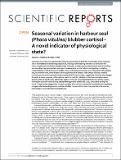Files in this item
Seasonal variation in harbour seal (Phoca vitulina) blubber cortisol - A novel indicator of physiological state?
Item metadata
| dc.contributor.author | Kershaw, Joanna L. | |
| dc.contributor.author | Hall, Ailsa J. | |
| dc.date.accessioned | 2016-03-11T13:00:09Z | |
| dc.date.available | 2016-03-11T13:00:09Z | |
| dc.date.issued | 2016-02-24 | |
| dc.identifier | 241557344 | |
| dc.identifier | 7871f26b-3f54-419d-b995-776a021b2a36 | |
| dc.identifier | 84959237006 | |
| dc.identifier | 000370684000001 | |
| dc.identifier.citation | Kershaw , J L & Hall , A J 2016 , ' Seasonal variation in harbour seal ( Phoca vitulina ) blubber cortisol - A novel indicator of physiological state? ' , Scientific Reports , vol. 6 , 21889 . https://doi.org/10.1038/srep21889 | en |
| dc.identifier.issn | 2045-2322 | |
| dc.identifier.other | Bibtex: urn:2dfc22b7343fc41a3d694fda61c98366 | |
| dc.identifier.other | ORCID: /0000-0002-7562-1771/work/47136306 | |
| dc.identifier.uri | https://hdl.handle.net/10023/8402 | |
| dc.description | The authors would also like to thank DRG International Inc. for their financial support that enabled the attendance of The European Cetacean Society Conference in 2012 where part of this work was presented. This work was partly supported by the National Capability Funding from the Natural Environment Research Council and by a School of Biology Class Grant. | en |
| dc.description.abstract | Cortisol is one of the main glucocorticoid hormones involved in both the mammalian stress response, and in fat metabolism and energy regulation, making it of increasing interest as a biomarker for stress, health and overall physiological state. However, transient stress responses to animal handling and sampling may be important sources of measurement artefact when investigating circulating concentrations of this hormone in wildlife. Here, cortisol concentrations were measured in the plasma and, for the first time, in the blubber of live captured adult harbour seals (Phoca vitulina). Plasma cortisol concentrations were positively correlated with capture time, suggesting that they were largely driven by a stress response to the capture event. In contrast, blubber cortisol concentrations were shown not to be significantly affected by capture time and varied significantly by sex and by season, with higher concentrations during natural fasting periods of their life cycle, particularly during the moult. These results suggest that cortisol may play a key role in increased fat metabolism during highly energetically demanding periods, and that blubber concentrations have the potential to be used as physiological state indicators in phocid seals. | |
| dc.format.extent | 9 | |
| dc.format.extent | 613301 | |
| dc.language.iso | eng | |
| dc.relation.ispartof | Scientific Reports | en |
| dc.subject | Ecophysiology | en |
| dc.subject | Fat metabolism | en |
| dc.subject | QH301 Biology | en |
| dc.subject.lcc | QH301 | en |
| dc.title | Seasonal variation in harbour seal (Phoca vitulina) blubber cortisol - A novel indicator of physiological state? | en |
| dc.type | Journal article | en |
| dc.contributor.sponsor | NERC | en |
| dc.contributor.institution | University of St Andrews. School of Biology | en |
| dc.contributor.institution | University of St Andrews. Sea Mammal Research Unit | en |
| dc.contributor.institution | University of St Andrews. Marine Alliance for Science & Technology Scotland | en |
| dc.contributor.institution | University of St Andrews. Scottish Oceans Institute | en |
| dc.identifier.doi | 10.1038/srep21889 | |
| dc.description.status | Peer reviewed | en |
| dc.identifier.grantnumber | Agreement R8-H12-86 | en |
This item appears in the following Collection(s)
Items in the St Andrews Research Repository are protected by copyright, with all rights reserved, unless otherwise indicated.

